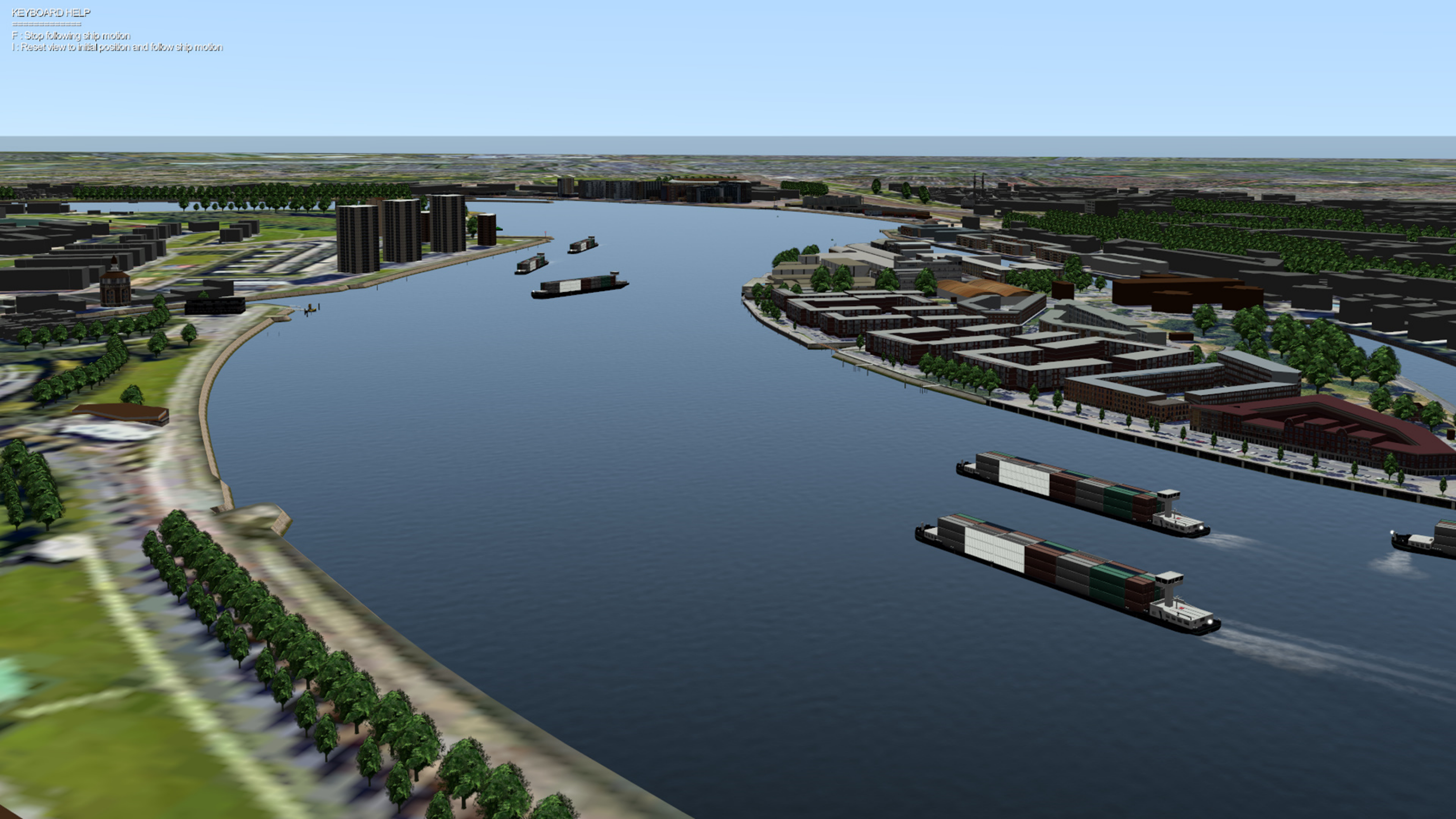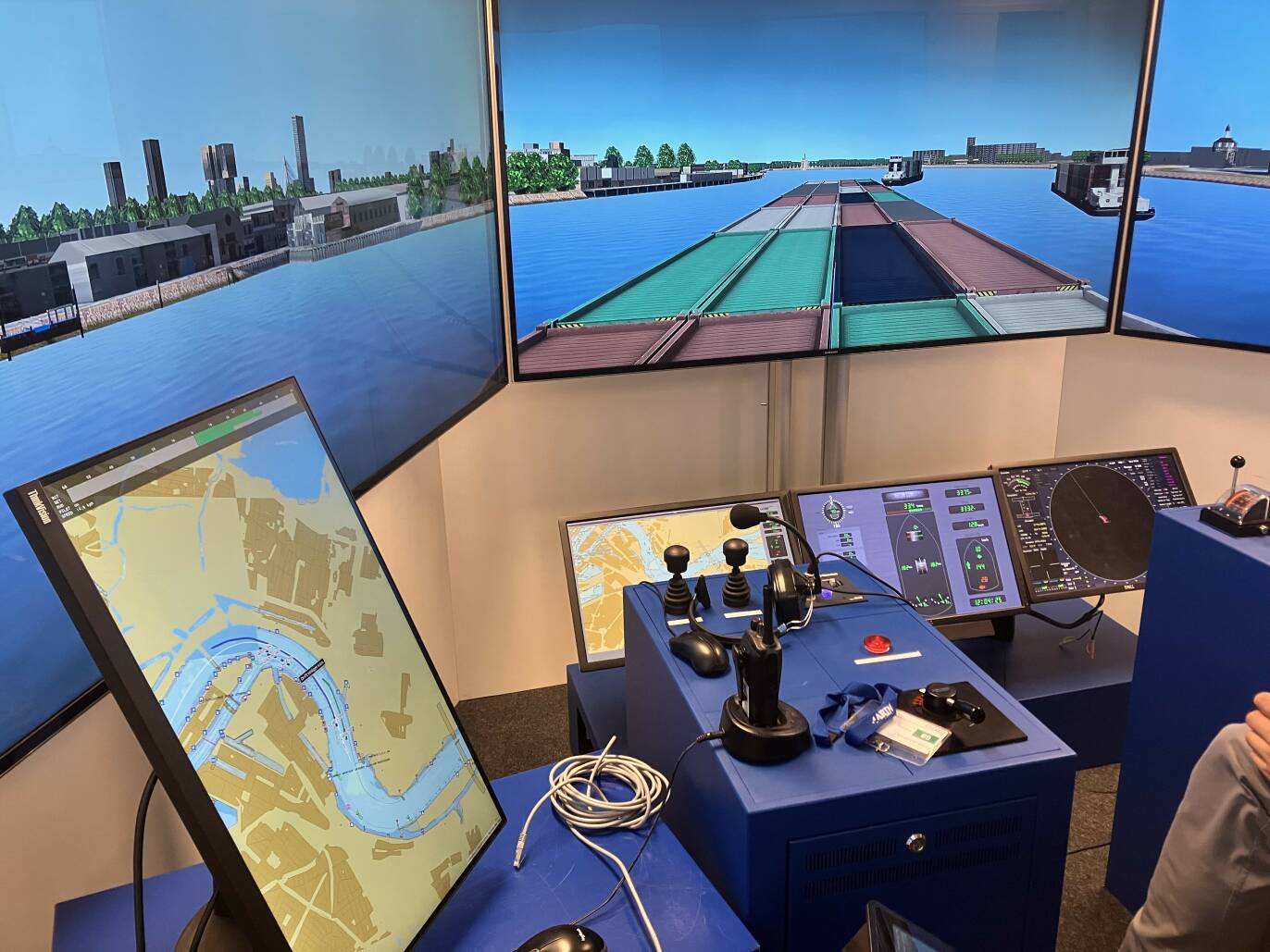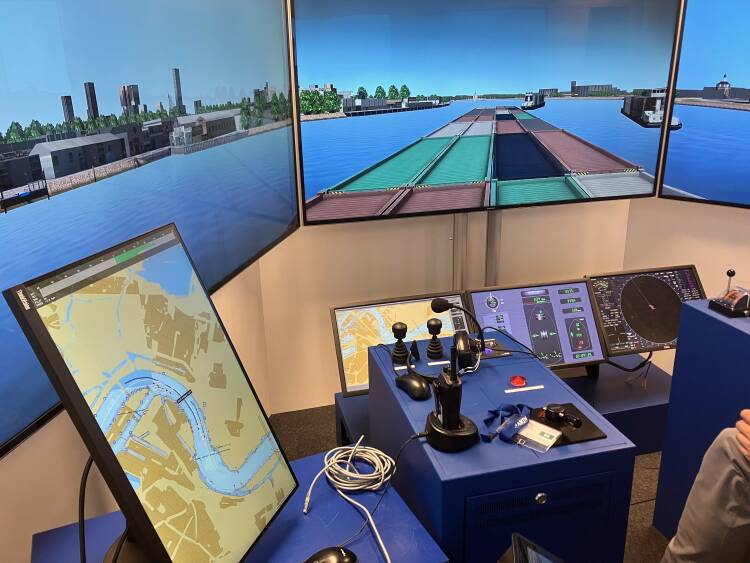




Digital intention sharing: simulation study on the benefits of intention sharing
Report

Create a MARIN account to stay updated
April 2023, no. 135
Screenshot from a performed simulation scenario showing the river Nieuwe Maas in Rotterdam (bocht van Esch).

MARIN’s mission to contribute to a safer and smarter use of our waters led to a pioneering simulation study into the concept of ‘intention sharing’ on board inland vessels.
Given the worldwide increase in marine traffic and its complexity, it is vital to explore how we make navigation safer and more efficient, Colin Guiking, MARIN’s Human Factor specialist explains. “We believe the concept of intention sharing could be part of the solution.”
Teaming up again with its longstanding client Rijkswaterstaat, (the Dutch Ministry of Infrastructure and Water Management), MARIN invited three leading track pilot manufacturers, namely Argonics, Shipping Technology and Tresco, to take part in a simulation study.
Accelerating innovation & improving safety
“This project is all about accelerating innovation and in this case automation on board of vessels which has the potential to improve safety and the efficiency of traffic flows. Additionally, there has not been a lot of research into the use of track pilots and intention sharing for inland shipping. With a track pilot, the vessel automatically sails a predetermined course.”
In a bid to investigate the human factor, a group of inland skippers were asked to see how intention sharing impacted their sailing behaviour and if the information shown on the interfaces was beneficial. Skippers were divided in two groups and each group was exposed to the same scenario, with or without intention sharing information, to test its added value. In both conditions, skippers used the trackpilot system to navigate, however the speed was controlled manually.

Simulator setup at MARIN. Intention sharing information shown on the left screen.
Impact on sailing behaviour
All the vessels in the simulation shared their intended route with each other and these were shown on their Electronic Navigational Chart (ENC) systems or a similar display. A standard model of an inland vessel was deployed of 110 m long x 11.4 m wide and two busy inland waterways were selected, and different traffic and weather conditions were simulated.
One example of a simulated scenario involved a dense traffic situation in a long, stretched-out bend, creating multiple route conflicts that needed to be resolved by the skippers. MARIN investigated how the skippers anticipated the upcoming traffic, course adjustments, their usage of VHF and of the intention sharing information using eye-tracking. By being able to see where the skippers were looking on the ENC it was possible to see which information was easy or more difficult to detect and understand, and to recognise information overload.
Patrick Potgraven
Rijkswaterstaat’s Strategic advisor Transport and Shipping

Kees Bart
Skipper

Moving towards strategic sailing
“The added value of this study is in confirming that it is certainly beneficial to be able to anticipate what is going to happen along the sailing route, make allowances, and adopt the best strategy for the vessel’s speed and course. This is moving towards management and strategic sailing, rather than operational sailing”. There are however, several important human factor issues that need to be considered, Colin stresses.
Insight into improving situational awareness
As part of the sailing task is now automated, this could lead to new risks of the skipper losing situational awareness, getting more detached from the sailing task, and therefore being less able to adequately react in time. There were also unexpected insights about risky side-effects when sailing with a trackpilot equipped with intention sharing. These include risk compensation behaviour due to higher perceived safety levels. For example, sometimes skippers assumed that the surrounding traffic would stay away from their own planned route and that wasn’t the case. Furthermore, we now have a better understanding of the information requirements needed to support situational awareness, Colin adds. “These insights help us to define the conditions and requirements to make this concept work.”
More info:



April 2023, no. 135








Digital intention sharing: simulation study on the benefits of intention sharing
More info:
Moving towards strategic sailing
“The added value of this study is in confirming that it is certainly beneficial to be able to anticipate what is going to happen along the sailing route, make allowances, and adopt the best strategy for the vessel’s speed and course. This is moving towards management and strategic sailing, rather than operational sailing”. There are however, several important human factor issues that need to be considered, Colin stresses.
Insight into improving situational awareness
As part of the sailing task is now automated, this could lead to new risks of the skipper losing situational awareness, getting more detached from the sailing task, and therefore being less able to adequately react in time. There were also unexpected insights about risky side-effects when sailing with a trackpilot equipped with intention sharing. These include risk compensation behaviour due to higher perceived safety levels. For example, sometimes skippers assumed that the surrounding traffic would stay away from their own planned route and that wasn’t the case. Furthermore, we now have a better understanding of the information requirements needed to support situational awareness, Colin adds. “These insights help us to define the conditions and requirements to make this concept work.”
Kees Bart
Skipper

Impact on sailing behaviour
All the vessels in the simulation shared their intended route with each other and these were shown on their Electronic Navigational Chart (ENC) systems or a similar display. A standard model of an inland vessel was deployed of 110 m long x 11.4 m wide and two busy inland waterways were selected, and different traffic and weather conditions were simulated.
One example of a simulated scenario involved a dense traffic situation in a long, stretched-out bend, creating multiple route conflicts that needed to be resolved by the skippers. MARIN investigated how the skippers anticipated the upcoming traffic, course adjustments, their usage of VHF and of the intention sharing information using eye-tracking. By being able to see where the skippers were looking on the ENC it was possible to see which information was easy or more difficult to detect and understand, and to recognise information overload.
Patrick Potgraven
Rijkswaterstaat’s Strategic advisor Transport and Shipping

Given the worldwide increase in marine traffic and its complexity, it is vital to explore how we make navigation safer and more efficient, Colin Guiking, MARIN’s Human Factor specialist explains. “We believe the concept of intention sharing could be part of the solution.”
Teaming up again with its longstanding client Rijkswaterstaat, (the Dutch Ministry of Infrastructure and Water Management), MARIN invited three leading track pilot manufacturers, namely Argonics, Shipping Technology and Tresco, to take part in a simulation study.
Accelerating innovation & improving safety
“This project is all about accelerating innovation and in this case automation on board of vessels which has the potential to improve safety and the efficiency of traffic flows. Additionally, there has not been a lot of research into the use of track pilots and intention sharing for inland shipping. With a track pilot, the vessel automatically sails a predetermined course.”
In a bid to investigate the human factor, a group of inland skippers were asked to see how intention sharing impacted their sailing behaviour and if the information shown on the interfaces was beneficial. Skippers were divided in two groups and each group was exposed to the same scenario, with or without intention sharing information, to test its added value. In both conditions, skippers used the trackpilot system to navigate, however the speed was controlled manually.
Simulator setup at MARIN. Intention sharing information shown on the left screen.

MARIN’s mission to contribute to a safer and smarter use of our waters led to a pioneering simulation study into the concept of ‘intention sharing’ on board inland vessels.

Report




